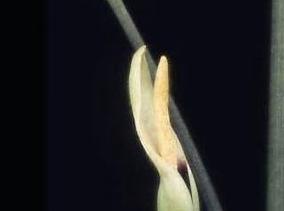Araceae
Arophyton Jum.
SUMMARY
HABIT : seasonally dormant herbs, rhizomatous or tuberous. LEAVES : 1-few. PETIOLE : sheath short. BLADE : cordate, hastate, trifid to trisect or pedatifid, primary lateral veins pinnate, forming submarginal collective vein, secondary laterals sometimes parallel-pinnate, otherwise higher order venation reticulate. INFLORESCENCE : (1-)2-3 in each floral sympodium. PEDUNCLE : subequal or shorter than petiole. SPATHE : not or slightly constricted between tube and blade, tube persistent at maturity or entire spathe marcescent, blade widely spreading, white or cream to greenish within. SPADIX : fertile to apex, or with short appendix, entirely free or female zone partly adnate to spathe, female zone contiguous with male, or separated by synandrodia or a few bisexual flowers. FLOWERS : unisexual, perigone absent. MALE FLOWER : 2-7-androus, stamens connate, synandrium elongate-ellipsoid, often irregularly shaped, shallow, truncate, sometimes with a central slit, common connective broad, thecae marginal, broad-ellipsoid to globular, dehiscing by slit or pore on upper surface. POLLEN : inaperturate, spherical to subspheroidal, medium-sized (mean 32 µm., range 27-36 µm.), exine spinose. FEMALE FLOWER : gynoecium surrounded by cup-like synandrodium, ovary 1-locular, ovule 1, orthotropous, funicle usually short, placenta basal, style short to relatively long and cylindric-conoid, or ± absent, stigma discoid. STERILE FLOWERS : truncate synandrodium with central cavity. BISEXUAL FLOWERS : as for female flowers, but surrounded by synandrium bearing a few scattered thecae. BERRY : ellipsoid to fusiform or clavate, red or green. SEED : ellipsoid to globular, testa thin, smooth, embryo large, globular or ellipsoid, plumule subapical, endosperm absent.





